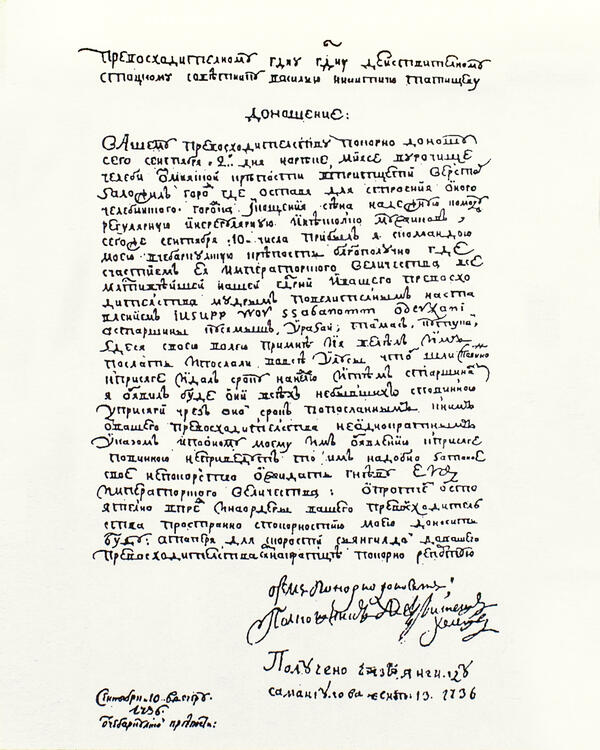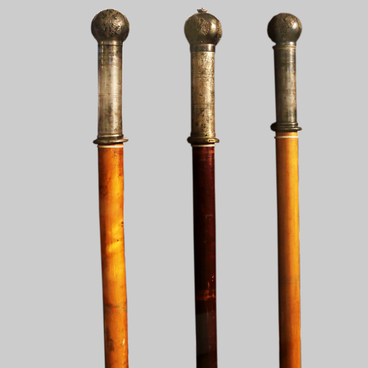The exhibition of the State Museum of the South Ural History includes a copy of the most important document in the history of Chelyabinsk: a report by A. I. Tevkelev to V. N. TatIshchev on the foundation of the Chelyabinsk Fortress.
The Russian colonization of the Southern Urals proceeded in three directions: to the east, in the direction of BashkIria, where Ufa became the first founded town; to the south, in the direction of the YaIk River, which is now called the Ural River; and from the north and northeast to the south and west, up the Iset River, and then along its tributaries, the Techa and the Miass. The latter area coincides with the present-day territory of the Chelyabinsk and Kurgan regions. Some fifteen fortresses were built here In the 17th century, giving rise to a whole semicircle of Russian settlements: Katayskaya, Okunevskaya, Chumlyakskaya, and others.
The influx of settlers to the Isetsky District sharply increased in the 1730s–1750s, when the Orenburg defense line, a vast system of border fortifications consisting of six chains of fortresses, was built in the Southern Ural. The fortresses were built by the Orenburg expedition, a special body set up in 1734. The plant was to deliver food from the Isetsky District and Siberia. However, the long road across uninhabited plots of land and opposition from the BashkIrs made the delivery of bread almost impossible. This could disrupt the construction of the city of Orenburg. It was decided to build several fortresses that would serve as waypoints for grain carts, give them shelter in bad weather, protection, and provide forage in winter. Thus appeared the Isetskaya line of fortresses, which became part of the Orenburg defense line.
The fortresses were built in a chain, with “no more than 30 verstas (about 32 kilometers) between them”, so that it would take no more than one or two days to travel from one fortress to another. The Chelyabinsk Fortress, which was part of the Isetskaya line and was founded on September 13, 1736 by Colonel Alexey Tevkelev, was built in strict accordance with this rule. In a report to his superior, he wrote, “To His Excellency State Councillor Vasily Nikitich Tatishchev: I humbly report to Your Excellency that I have founded a town on the Miass River in the Chelebi tract, 30 verstas from the Miass fortress, on September 2, leaving a reliable team of regulars and irregulars as well as a few peasants to build the town of Chelebinsk and cut hay, and safely arrived at the Chebarkul fortress with my team on September 10. Dutifully reported by Colonel Alexey Tevkelev. September 10, 1736, the Chebarkul fortress.”
Tatishchev received Tevkelev’s report from the Bashkir messenger Yangilda Samangulov on September 13, 1736.
The Russian colonization of the Southern Urals proceeded in three directions: to the east, in the direction of BashkIria, where Ufa became the first founded town; to the south, in the direction of the YaIk River, which is now called the Ural River; and from the north and northeast to the south and west, up the Iset River, and then along its tributaries, the Techa and the Miass. The latter area coincides with the present-day territory of the Chelyabinsk and Kurgan regions. Some fifteen fortresses were built here In the 17th century, giving rise to a whole semicircle of Russian settlements: Katayskaya, Okunevskaya, Chumlyakskaya, and others.
The influx of settlers to the Isetsky District sharply increased in the 1730s–1750s, when the Orenburg defense line, a vast system of border fortifications consisting of six chains of fortresses, was built in the Southern Ural. The fortresses were built by the Orenburg expedition, a special body set up in 1734. The plant was to deliver food from the Isetsky District and Siberia. However, the long road across uninhabited plots of land and opposition from the BashkIrs made the delivery of bread almost impossible. This could disrupt the construction of the city of Orenburg. It was decided to build several fortresses that would serve as waypoints for grain carts, give them shelter in bad weather, protection, and provide forage in winter. Thus appeared the Isetskaya line of fortresses, which became part of the Orenburg defense line.
The fortresses were built in a chain, with “no more than 30 verstas (about 32 kilometers) between them”, so that it would take no more than one or two days to travel from one fortress to another. The Chelyabinsk Fortress, which was part of the Isetskaya line and was founded on September 13, 1736 by Colonel Alexey Tevkelev, was built in strict accordance with this rule. In a report to his superior, he wrote, “To His Excellency State Councillor Vasily Nikitich Tatishchev: I humbly report to Your Excellency that I have founded a town on the Miass River in the Chelebi tract, 30 verstas from the Miass fortress, on September 2, leaving a reliable team of regulars and irregulars as well as a few peasants to build the town of Chelebinsk and cut hay, and safely arrived at the Chebarkul fortress with my team on September 10. Dutifully reported by Colonel Alexey Tevkelev. September 10, 1736, the Chebarkul fortress.”
Tatishchev received Tevkelev’s report from the Bashkir messenger Yangilda Samangulov on September 13, 1736.




